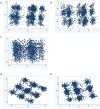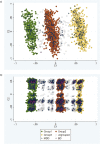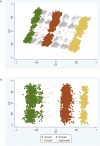The overlap of genetic susceptibility to schizophrenia and cardiometabolic disease can be used to identify metabolically different groups of individuals
- PMID: 33436761
- PMCID: PMC7804422
- DOI: 10.1038/s41598-020-79964-x
The overlap of genetic susceptibility to schizophrenia and cardiometabolic disease can be used to identify metabolically different groups of individuals
Abstract
Understanding why individuals with severe mental illness (Schizophrenia, Bipolar Disorder and Major Depressive Disorder) have increased risk of cardiometabolic disease (including obesity, type 2 diabetes and cardiovascular disease), and identifying those at highest risk of cardiometabolic disease are important priority areas for researchers. For individuals with European ancestry we explored whether genetic variation could identify sub-groups with different metabolic profiles. Loci associated with schizophrenia, bipolar disorder and major depressive disorder from previous genome-wide association studies and loci that were also implicated in cardiometabolic processes and diseases were selected. In the IMPROVE study (a high cardiovascular risk sample) and UK Biobank (general population sample) multidimensional scaling was applied to genetic variants implicated in both psychiatric and cardiometabolic disorders. Visual inspection of the resulting plots used to identify distinct clusters. Differences between these clusters were assessed using chi-squared and Kruskall-Wallis tests. In IMPROVE, genetic loci associated with both schizophrenia and cardiometabolic disease (but not bipolar disorder or major depressive disorder) identified three groups of individuals with distinct metabolic profiles. This grouping was replicated within UK Biobank, with somewhat less distinction between metabolic profiles. This work focused on individuals of European ancestry and is unlikely to apply to more genetically diverse populations. Overall, this study provides proof of concept that common biology underlying mental and physical illness may help to stratify subsets of individuals with different cardiometabolic profiles.
Conflict of interest statement
The authors declare no competing interests.
Figures





Similar articles
-
Exploring shared genetic bases and causal relationships of schizophrenia and bipolar disorder with 28 cardiovascular and metabolic traits.Psychol Med. 2019 Jun;49(8):1286-1298. doi: 10.1017/S0033291718001812. Epub 2018 Jul 26. Psychol Med. 2019. PMID: 30045777
-
Association of Genetic Liability to Psychotic Experiences With Neuropsychotic Disorders and Traits.JAMA Psychiatry. 2019 Dec 1;76(12):1256-1265. doi: 10.1001/jamapsychiatry.2019.2508. JAMA Psychiatry. 2019. PMID: 31553412 Free PMC article.
-
Shared Genetic Loci Between Body Mass Index and Major Psychiatric Disorders: A Genome-wide Association Study.JAMA Psychiatry. 2020 May 1;77(5):503-512. doi: 10.1001/jamapsychiatry.2019.4188. JAMA Psychiatry. 2020. PMID: 31913414 Free PMC article.
-
Examining How Our Shared Evolutionary History Shapes Future Disease Outcomes.Glob Heart. 2017 Jun;12(2):169-171. doi: 10.1016/j.gheart.2017.01.008. Epub 2017 Mar 13. Glob Heart. 2017. PMID: 28302556 Free PMC article. Review.
-
Genetic variation, adipokines, and cardiometabolic disease.Curr Opin Pharmacol. 2020 Jun;52:33-39. doi: 10.1016/j.coph.2020.04.006. Epub 2020 May 29. Curr Opin Pharmacol. 2020. PMID: 32480034 Review.
Cited by
-
Ceramides: Shared Lipid Biomarkers of Cardiovascular Disease and Schizophrenia.Consort Psychiatr. 2021 Nov 5;2(3):35-43. doi: 10.17816/CP101. eCollection 2021. Consort Psychiatr. 2021. PMID: 39044755 Free PMC article.
-
Quantifying the relative importance of genetics and environment on the comorbidity between mental and cardiometabolic disorders using 17 million Scandinavians.Nat Commun. 2024 Jun 13;15(1):5064. doi: 10.1038/s41467-024-49507-3. Nat Commun. 2024. PMID: 38871766 Free PMC article.
-
Impact of polygenic risk for coronary artery disease and cardiovascular medication burden on cognitive impairment in psychotic disorders.Prog Neuropsychopharmacol Biol Psychiatry. 2022 Mar 8;113:110464. doi: 10.1016/j.pnpbp.2021.110464. Epub 2021 Oct 29. Prog Neuropsychopharmacol Biol Psychiatry. 2022. PMID: 34756932 Free PMC article.
-
Implication of Melanocortin Receptor Genes in the Familial Comorbidity of Type 2 Diabetes and Depression.Int J Mol Sci. 2022 Jul 28;23(15):8350. doi: 10.3390/ijms23158350. Int J Mol Sci. 2022. PMID: 35955479 Free PMC article.
-
Polygenic risk for psychotic disorders in relation to cardiac autonomic dysfunction in unmedicated patients with schizophrenia.Eur Arch Psychiatry Clin Neurosci. 2025 Apr;275(3):863-871. doi: 10.1007/s00406-024-01933-6. Epub 2024 Nov 6. Eur Arch Psychiatry Clin Neurosci. 2025. PMID: 39503783 Free PMC article.
References
Publication types
MeSH terms
Grants and funding
LinkOut - more resources
Full Text Sources
Other Literature Sources
Medical

